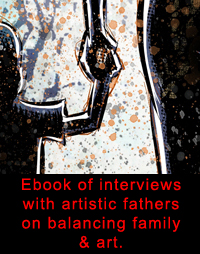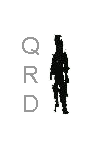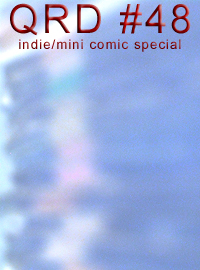
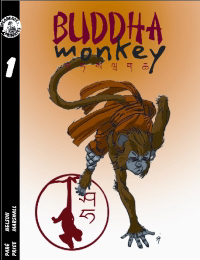
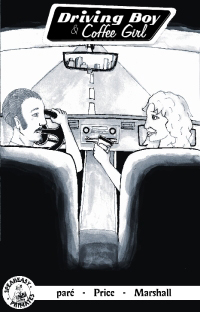
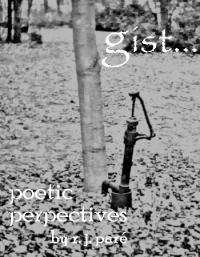
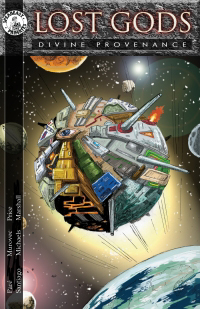
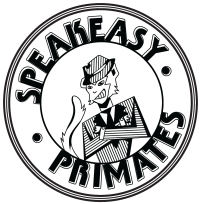
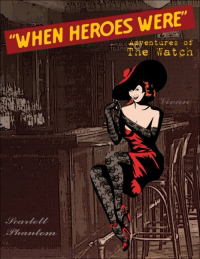








February 2011
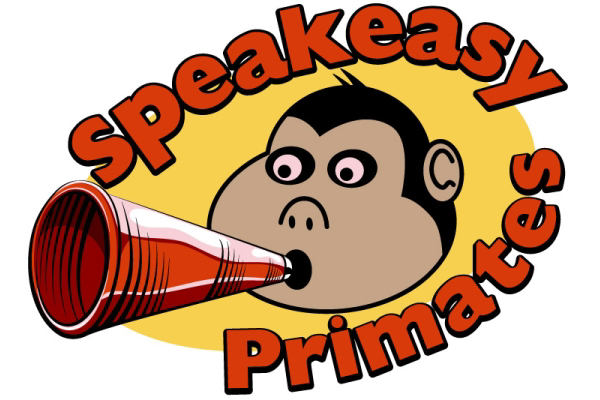
City: Orillia Ontario, Canada
Comics: Buddha Monkey, The Adventures of Driving Boy & Coffee Girl
(also in production: SEISMIC, Hell on Earth, The Lost Gods, When Heroes Were - & a comic adaptation of Mike Grattan’s youth fantasy novel “Raymond Thursday’s Suitcase”)
Websites: www.comicbookdb.com/creator.php?ID=30182, www.facebook.com/group.php?gid=11728619899, www.wix.com/speakeasy_primates/speakeasy-primates
QRD – How old were you when you first got into comics & did you always stick with them or did you come back to them?
RJ – I think the first comic I ever read was one of those “Archie” digests when I was very small. A little later, while visiting my grandparents’ farm I discovered an old box of Marvel Comics that one of my Uncles had left & had tons o’ fun reading through them. But my obsession with comics really took root on a road trip to go camping on Manitoulin Island, when I was 12 or 13. We had stopped at a gas station & my Dad gave me & my brothers some change to grab ourselves a treat in the store. I spent mine on a JLA/JSA crossover billed as “Crisis on Earth-Prime!” This comic had everything; parallel worlds, alternate & evil versions of heroes... & a time traveling Nazi as the big bad villain!!! It blew my adolescent mind. In short order I was hooked on these four-colour adventures & have been ever since.
QRD – What was the first comic book you ever bought?
RJ – The “Archie” stuff was given to me when I was probably 5 or 6. I started spending my allowance on comics when I was around 8... mostly on Green Lantern. As I recall, at that age I would daydream of wielding a power ring. :)
QRD – How old were you when you put out your first comic?
RJ – I began writing genre material while in high school, notably through collaborations with the Windsor & Essex County Comic Collectors Club (W.E.C.C.C). Their newsletters (North Words), underground comics (Arcane), & fanzines (RKYV) were a wonderful environ for an aspiring creator to hone their craft. I am proud to be one of several W.E.C.C.C. alums who continue to strive to create entertaining & thoughtful works of art & fiction, to this day. Other notable W.E.C.C.C. alums include Roy G. James - artist/author/poet; David Marshall - graphic designer layout editor/letterer; Marc Ngui - artist/graphic designer; Mark Laliberte - Editor Carousel Magazine/visual & audio artist.
QRD – Why comics instead of just writing or drawing?
RJ – Well I don’t believe “instead” really applies in this case. I write short stories & have a couple novels in the works. I have self-published my first collection of poetry: “Gist: poetic perspectives” & am very interested in trying my hand at screenwriting someday.
QRD – Do you see mini-comics & indie comics as paths to mainstream comics or as their own unique media?
RJ – That really depends. You simply cannot intend to reach the mainstream via self-published indie works, the odds are very much against that. They are inherently a separate art form from mainstream comics, in the sense that they are not bound by preconceived notions of form & content. Put it this way, indie comics are to the mainstream what surrealism is to portraiture... or at least they can be. However, occasionally an indie creator will wind up with such a critical success that doors are opened for them. & in such a case, who is going to turn down an opportunity to write or draw the comics you loved as a child... for the kind of money the big boys are willing to pay?
QRD – How many copies of your comic do you print in your first run?
RJ – Considering I have only ever printed enough copies for any given convention season (my sales are, so far, limited to exhibitor tables at small press cons) I have limited myself to approx. 100 copies of a given book.
QRD – How much do you think comics should cost?
RJ – Wow, that is a difficult question to answer. Comics as a business differ greatly from comics created as purely an expression of creative impulse. I cannot speak for comics as a business as I cannot hope to support myself via sales of my books. For me they are purely a labour of love that I hope to break even on. I am certain those professionals that do support themselves, via comics, have to make very difficult decisions based on the length of time necessary to create the book & how many artists (writer, penciler, inker, colourist, letterer) were involved & must receive compensation. Which is why comics prices vary so much. The major publishers like DC, Marvel, & Image sell at such volumes they can easily set their prices lower than the average indie book (DC’s current policy of “drawing the line at $2.99” for example). Ultimately the only answer is: “What you can live with.”
QRD – How many books do you produce a year & how many would you like to?
RJ – As a writer, I could finish several standard comic scripts a month, given the opportunity. However, collaborating with artists necessitates greater patience as they can only draw so fast... LOL. Ideally I would like my studio’s sales to reach a point where we can justify the investment of time, on the part of the writers & artists involved, to create a full 24 page comic per month or two 96+ page graphic novels per year.
QRD – Do you think stories should be serialized or delivered as complete works?
RJ – Some works should definitely be serialized - if each 20+ page chapter has a rhythm, a pace that is episodic in nature. Longer story arcs, however, should be presented in their entirety as they are meant to be read the way they were written - one epic tale.
QRD – How are comic strips different than comic books & which medium do you prefer?
RJ – I’ve only ever dabbled in strips. They are a very condensed form of comic expression & require a very different skill set than prose or script writing. It would be fair to compare them to poetry in the sense that you are using a few short words, symbols, & images in order to communicate.
QRD – How long is it from when you start a comic until it’s printed?
RJ – As I mentioned a few questions ago, it really depends on how fast the artist can work. As a writer in a visual medium I am at the mercy of those gifted with talents I do not possess & skills that I greatly admire.
QRD – What do you do better with your comics now than when you first started?
RJ – Well, I think I am finding a better balance in my pacing. Not every story needs to be a massive long-form epic, nor do they need to be a “one-shot.” I am always trying to improve my ability to tell “Sequential - Episodic” tales: stories that can be enjoyed on their own while still developing a larger context or story arc.
QRD – At what point in the artistic process do you work digitally?
RJ – Some of the artists in our studio ink digitally, some ink traditionally - while some skip inking altogether & deal with blacks & greys during colouring (which is almost always digital nowadays). It depends entirely on the project.
QRD – What do you think of digital comics & webcomics?
RJ – I think that digital content is the wave of the future as far as reading ongoing monthly comics is concerned. Limited series & Graphic Novels are where the print medium will still be preferred. By the consumer because nothing beats holding a complete tale in your hands & by the publishers/creators because the potential profits of print dwarf those of digital distribution. Collectors will also play a huge part in this evolution. I suspect a “digital is for reading”/”print is for collecting” mentality is already beginning to take root.
QRD – Do you prefer working in color or black & white?
RJ – Cost-wise, black & white is the way to go. To be honest, some projects look better that way, anyhow. However, when possible, the kid in me still loves those vibrant colours.…
QRD – How many different people should work on a comic & what should their jobs be?
RJ – Again, like many of the previous questions, there is no “right” answer. This will depend on the folks involved, how much time any one creator can invest on a project & what talents & skills they possess. Financially speaking it’s the same as being in a band. A solo act gets paid more than an ensemble because they ain’t “splitting the door.” As I’ve said though, I’m not in it for the money. I enjoy having a large team, from start to finish, to brainstorm with & develop the project. A writer/letterer, penciler, inker, & colourist seems to make up the standard quartet I “gig” with.
QRD – How do you find collaborators?
RJ – I’ve run an art/lit e-Zine, for many
years now, called RKYV ONLINE (pronounced “archive”). Every month
we publish art, short stories, poetry, & articles from online submissions.
The magazine has been around for years & has a growing audience (some
issues surpassing 90, 000 views). We offer RKYV as a freely distributed
celebration of art & literature. It can be enjoyed in PDF & multiple
e-Book formats. If you are curious about the magazine, just follow the
link below (one of many sites it is hosted on) & click on any given
issue to launch the viewer (no download necessary).
http://www.scribd.com/randy_par%C3%A9/shelf
Now RKYV has been a great way for me to
get to know other creators. A couple years ago, some of us writers &
artists got to talking about our frustrations with the status-quo of small
press publishing & the hassles of needing to hire someone to help finish
a project we’d been working on. Our solution was to form a cooperative.
Speakeasy Primates Studio was founded on the idea that a group of us would
donate our time & talents to each other’s projects in order to see
them through from concept to print. For example, if one member artist needs
a writer, editor, or letterer on one of their projects - I’ve gladly stepped
in to help & in return that artist has helped out (either with concept
design, pencils, inks, or colours) on one of my projects. On each project
we agree to split sales revenue accordingly (based on workload - the lion’s
share going to the artists as they have a greater workload than writers
or letterers). So far it has been a very rewarding experience creatively.
QRD – How tight do you think a script should be as far as telling the artist what to draw?
RJ – I am a firm believer in letting the artist do what they do best - visualize & render scenes as though they were sitting in the “director’s chair”. The job of the writer is to develop extremely detailed notes & outlines. Then when it comes time to draft the script for the lead artist/penciler - they should create a loose “page script” where the action, settings, interactions & dialogue are summarized. After the pencils are finished, I ask the artist to send me copies so that while the inking & colouring are taking place I can then draft a finished “panel script”, based on the visuals, which can be forwarded to the letterer.
QRD – What comic book person would you be most flattered to be compared to?
RJ – While I am light-years away from these guys, in terms of talent & accomplishment, if anyone reading my work could experience a fraction of the joy they do when reading a tale by Marv Wolfman or Geoff Johns - it’d “knock my socks off.” These writers combine the wonder, awe, & imagination of fan-boys with the superb ability to develop a character’s voice & re-define their personality to such an extent that the character truly becomes “theirs” & succeeding writers are faced with an enormous challenge when taking over a book they have written. I try very hard, in my writing, to satisfy both my inner child & my English Major. I believe concepts & plots should be dreamt big - since, unlike film, our canvas has an unlimited special effects budget - while our dialogue & character interaction should feel real, natural, & intimate.
QRD – What do your friends & family think of your comics?
RJ – This ranges from the insulting “why do you still waste your time on that?” to the patronizing, “oh, that’s nice.…” LOL. Create because you must... period. Do not seek validation from your friends & family - just be proud of your work. In the end if people dig your books, & buy them, that’s gravy. :)
QRD – What do you think of superheroes?
RJ – How can you work in comics & NOT have utterly loved superheroes at some point? The uber-artsy indie folks who swear up & down they’ve never liked superheroes are lying to you. Yes, I said it - they are lying to you & to be fair, maybe themselves as well. In an effort to appear more hip, cool, & interesting they will adopt a guise. This mask usually consists of black clothes, a retro-hat &/or unique trim to their facial hair. LOL. They’ve co-opted the appearance of Beat Poets in order to be “taken more seriously” - they’re tortured artists, don’t cha know? I freely admit, right here, right now - & at the risk of losing any & all indie cred: “I played with action figures as a child.” There I said it, now when do the art-gestapo come & confiscate my black t-shirts? I do think superheroes get the bulk of the press coverage, which in turn means many folks still think comics are strictly for kids. But hey, we didn’t create our books for non-comics fans - so I could care less whether they think the art form is limited to the Super Friends. Superheroes sell, way more than anyone cares to admit & as such they will continue to dominate the market. It is what it is, but don’t let it affect the kinds of stories you want to tell. I’ll say it again: “Create because you must... period.”
QRD – Marvel or DC?
RJ – Well, I used to take sides when I was younger (Johnny DC - represent!). But nowadays I follow my favourite creators. If George Perez is drawing a book - I know I’ll buy it. If Garth Ennis is writing a book - I know I’ll buy it. & so on.…
QRD – What comic characters other than your own would you like to work with?
RJ – As I think I mentioned earlier a certain,
power-ring wielding, champion known for traveling the cosmos & protecting
far-flung worlds from certain doom... comes to mind.
“I want to say, I wish I might,
Help Hal Jordan in his fight,
To stop evil & its blight,
With my keyboard I’ll... Green Lantern
write!”
(LOL, I am such a geek)
QRD – Ideally would you self-publish?
RJ – I do already, if I could find a publisher willing to shell out the clams themselves, whoo boy I’d be all over that like a fat kid on a Smartie.
QRD – What conventions do you try to attend & why?
RJ – First & foremost I attend S.P.A.C.E. every year in Columbus. The “small press only” atmosphere is perfect for our studio. The other creators have had a profound impact on me... their advice, critique, & camaraderie have made each S.P.A.C.E. as much a learning experience as it was an entertaining opportunity to network & make sales. Frankly I don’t want to setup shop with my ashcans & mini-prints next door to a $5000 multi-media booth in one of those mega-cons. I’d never sell enough stuff to cover the huge table fees & would feel awful shabby not having a flat screen & paid models behind me.... LMAO. But, come to think of it, if Bob ever wants to shell out for some sexy models to walk the floor & pose by all our tables & characters... well, I wouldn’t complain.... (just don’t let my wife know)
QRD – What do you do to promote your books?
RJ – Social Networks. Join them, use them. Chat & interact with your peers & your potential audience.
QRD – Do you think your comics are well suited to comic shops or would sell better elsewhere?
RJ – Only time will tell. I hope that by keeping my prices as low as I can & by participating in the annual “free comic book day” that I might develop a greater comic shop readership, as time goes on. In the meantime, I will begin making my books available as digital downloads (apps) via services such as Cloud 9 Comix & WOWIO.
QRD – What other medium would you like to see some of your comics made into (television, film, games, action figures, etc.)?
RJ – Currently we are developing an animated short in order to “pitch” Buddha Monkey as a cartoon. With any luck an established TV studio will find the project worthy.... So the answer is “all of the above” - I would totally dig seeing Speakeasy Primates books & characters adapted into other mediums such as you’ve listed & including video games!
QRD – Do you consider yourself a comic collector or a comic reader or both?
RJ – I am a comic reader who happens to collect certain books by certain creators.
QRD – What do you see as the most viable mediums for comics distribution 10 years from now?
RJ – Digital Comics for reading ongoing monthlies - print for reading Graphic Novels &/or collecting.
QRD – What would you like to see more people doing with comics?
RJ – Pushing boundaries creatively, while understanding this is not a path to riches, but rather an opportunity to express yourself artistically.
QRD – Anything else?
RJ – In addition to the print comics we
sell at cons, in some select stores & online we are beginning to serialize
some as web-comics & this should help us continue to establish &
connect with our target audience. We will be appearing at S.P.A.C.E. 2011,
of course, so please stop by our table & have a chat!






